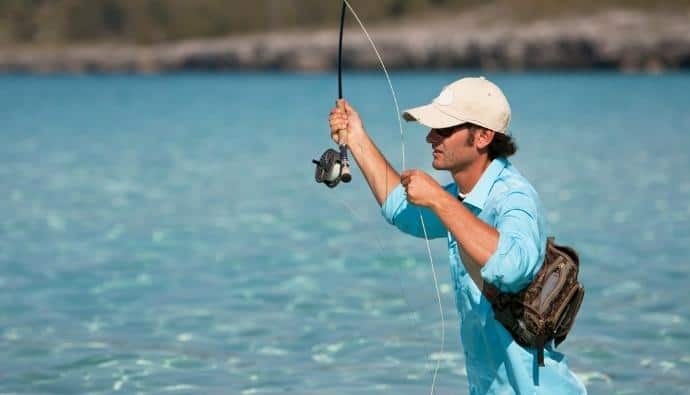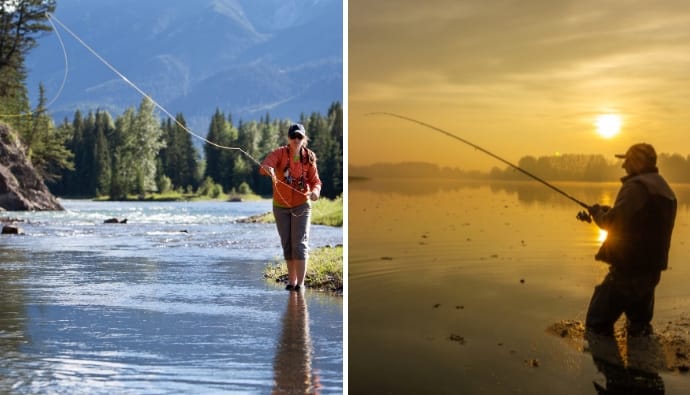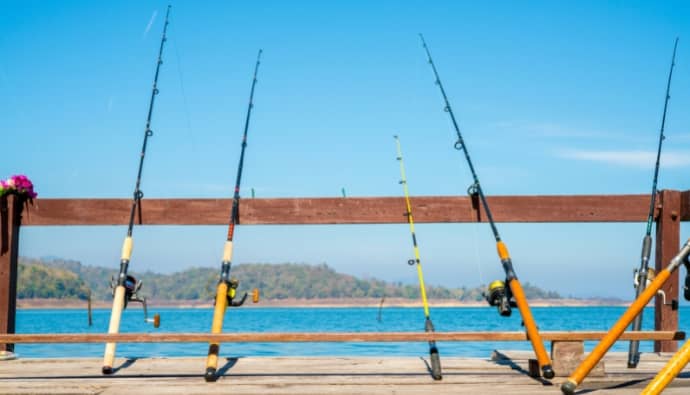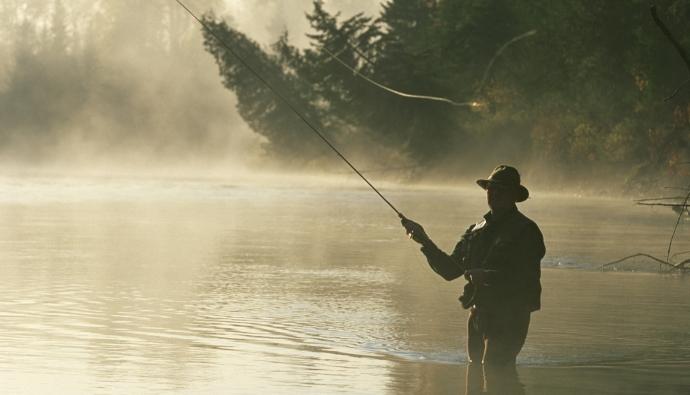Have you ever stood at the shoreline, watching as the waves crash against the shore? The sound of the water, the smell of salt in the air, and the feel of sand between your toes.
It’s no wonder that so many people love going to the beach. But what if we told you that there was a way to make that beach experience even more magical? Say hello to surf fly fishing – a thrilling new way to enjoy the great outdoors and get up close with some of nature’s most majestic creatures.
With surf fly fishing, you can cast your line out into the ocean and watch as schools of fish swim by, gently buffeted by the waves. It’s an experience like no other and one that we think everyone should try at least once.
We talked to Dave Hurley, a California transplant but now fly fishing in Michigan and an expert in the field, to know more about surf fly fishing. So, if you’re ready to get started on your surf fly fishing journey, read on for our top tips!
What is Surf Fly Fishing?
Surf fly fishing is the perfect way to get your feet wet in fly fishing. It is a great sport for those who enjoy being outdoors and the waves.
In surf fly fishing, you use a small, light rod to cast your line into the surf. The waves help keep your line tight, and you will use various bait to catch your fish.

Types of Casting in Surf Fly fishing
Surf fly fishing can be a tricky and challenging sport, but it is also immensely rewarding with the right tools and techniques.
You can use several different casting styles in surf fly fishing, each of which requires a unique combination of skill, timing, and finesse. Whether you prefer short or long casts or you need to cast around obstacles, there is a casting style that will suit your needs.
Here are some of the most popular types of casts used in surf fly fishing:
Overhand Cast
The overhand cast is the most basic and common type used in surf fly fishing. It is also the easiest to learn and master.
Hold the rod in your dominant hand and swing it back and forth in a smooth, controlled motion to execute an overhand cast. Then, release the line with a quick wrist snap to send the lure flying through the air.
Roll Cast
A roll cast is a great option if you need to cast quickly or get your lure into tight spaces. Bring the rod back over your shoulder as you would for an overhead cast to do a roll cast. Then, release the line and let it roll off the rod’s tip. The momentum of the roll will send the lure flying through the air.
Sidearm Cast
A sidearm cast is ideal for casting in overhanging vegetation or windy conditions. In a sidearm cast, you need to use the power generated from your legs to help propel the rod and line forward.
To do a sidearm cast:
- Stand sideways with one foot slightly in front of the other.
- Hold the rod out to your side and reel in enough line so that it is taut.
- Push off of your back leg and swing the rod forward, releasing the line as you do so.
Backhand Cast
A backhand cast is a great option for casting on the opposite side of your body. Your dominant stays active throughout the cast, while your non-dominant hand provides the power.
Start by holding the rod in your dominant hand and placing your non-dominant hand behind your back. Then, swing the rod forward and release the line as you do so.
Double Haul Cast
The double haul cast is a more advanced technique used to cast long distances. It is also great for casting in windy conditions. First, make an initial back cast to execute a double haul cast. As you bring the rod forward on the forward cast, haul the line in with your non-dominant hand.
This will help to generate more speed and power behind the cast. Then, release the line with a quick snap of the wrist.
“You want to be able to cast efficiently, and the best way to do that is a double haul and to like a load that rod quick. And that’s where the sinking line shines with a faster rod. And so, honing that skill and getting efficient at it’s going to be huge for any fly fisherman looking to get started in the surf,” Dave Hurley said.
The Benefits of Surf Fly Fishing
Some people are on the fence about whether to get into surf fly fishing or not. However, many benefits of surf fly fishing make it worth considering. Here are some of the benefits:
Catch a Variety of Fish
One of the great things about surf fly fishing is catching various fish. Many different types of fish live in saltwater habitats, and you can target them all with the right flies and techniques.
Access to More Fishing Spots
You can access many different fishing spots when you are surf-fly fishing since the shoreline is generally much closer to these spots than it is for other types of fishing. This gives you greater flexibility regarding where and when you can go fishing, which means more opportunities to get out on the water and catch fish.
Fun for All Ages
Surf fly fishing is an excellent activity for people of all ages. It is not only a great way to get outside and enjoy the fresh air, but it is also a great way to bond with family and friends. Whether you are just getting started or a seasoned pro, there is always something new to learn and enjoy about surf fly fishing.
A Great Workout
Surf fly fishing is also a great workout. It requires you to use your whole body, and you can get a workout in by wading out into the water and casting your line.
Beautiful Scenery
When you are surf-fly fishing, you will often be surrounded by beautiful scenery. Whether you are fishing from the beach or a pier, you will be surrounded by the ocean and its natural beauty.
What You Need to Start Surf Fly Fishing
To get started in surf fly fishing, you will need a few key things:
Good Quality Rod and Reel
A good rod and reel are essential to surf fishing. You will want a lightweight and durable rod with a long enough casting range to reach distant targets. A good quality reel is also crucial; you will want something that can hold plenty of lines and can be easily adjusted to suit your needs.
Proper Wading Gear
To get into surf fly fishing, you will also need to invest in some good heavyweight wading gear.
Dave Hurley said, “And little heavy gear, probably like a seven weight or a six weight, up to like eight weights, maybe a nine, but, mostly in that six to seven weight.”
This includes heavy-duty waders with boots for ensuring your feet stay dry and warm. You may also consider investing in a wet suit or other protective clothing, particularly if the water is cold or choppy.
Guide or Instructor
Surf fly fishing can be a challenging and complex sport, so it is highly recommended that you seek an experienced guide or instructor to help you get started. This will ensure you have the knowledge and skills you need to succeed in your new hobby.
Strong Focus on Safety
Safety should always be your top priority when surf fishing. Make sure you are aware of your surroundings and the conditions of the sea before heading out and always have a plan in place in case of emergencies. Remember to pack plenty of food and water and stay within reach of help at all times.
Casting Bucket
Your line might pile up at your feet as you cast, so it is good to invest in a casting bucket to store your line. This will allow you to maintain control of your line and prevent tangles as you fish.
According to Dave Hurley, “Another essential fishing piece would be your casting bucket or some sort of basket to catch your line. Fly fishing, to those who aren’t familiar, you have a line to deal with that can pile up at your feet when you’re standing, gets wrapped in kelp, or can kind of get wrapped up in your feet with all the current and the water slushing around. So having a device that catches that line at your waist makes that possible.”
Solid Understanding of Surf Fishing Techniques
To be successful in surf fly fishing, you must understand the various techniques and strategies involved. This may include everything from reading the waves to choosing the right flies for different fish species. You can quickly become a skilled surf fly fisher with some practice and guidance!
“The surf can be a big challenge. So instead of having like a river where the current goes one way, you have a current going sideways, forwards, and backward,” Dave Hurley said.
How to Cast for Surf Fly Fishing
With its rolling waves and endless coastlines, surf fly fishing is the perfect escape for anyone looking to get away from the hustle and bustle of city life. But stepping into this exciting new world can be intimidating – after all, you need to master challenging casting techniques and become attuned to the unique rhythms of the ocean.
“And when you’re in the surf, casting really becomes important. As far as actually being successful, if you’re a trout fly fisherman or somebody who is used to light tackle stuff, the surf can be a big challenge,” according to Dave Hurley.
If you want to learn how to cast, here are some tips:
Master the Basics of Fly Fishing
Before you hit the waves, it’s essential to have a strong foundation in the sport. This means learning how to rig your tackle, identify different species of fish, and most importantly – how to cast.
According to Dave Hurley, “Being able to cast consistently at least 60 feet is probably a good advantage.”
Practice in Calm Waters
Surf fly fishing can be daunting, but it’s important to remember that everyone starts somewhere. Try practicing your casting in calmer waters before venturing out into the surf if you’re unsure. This will allow you to build up your confidence and refine your technique.
Pay Attention to the Tides
The tide can have a huge impact on the quality of your fishing experience, so it’s important to know when to go out and hit the waves. When planning your trip, make sure you consider the time and strength of both high and low tides – this can help you anticipate where the fish will be and improve your chances of success.
Stay Patient and Persistent
Like all forms of fishing, surf fly fishing requires a lot of patience and persistence. Whether you’re casting to the breaking waves or waiting for a fish to bite, staying calm and focused is important. By approaching this sport with an open mind and positive attitude, you can overcome any challenges and truly enjoy all the excitement and beauty of surf fly fishing.
How to Read the Water for Surf Fly Fishing
Surf fly fishing is a unique and challenging sport that can be extremely rewarding. It is important to understand how to read the water. Here are some tips on how to get started:
Look for Ripples and Small Waves
When fly fishing in the surf, you will want to look for ripples and small waves. These can be an indication of where the fish are feeding.
Dave Hurley said, “Ripple currents are a big tractor for fish. It’s like a river within an ocean. So you have that ripple current, and the fish will line up in there and use it as a feeding trough. And that’s where you’ll find more concentrated fish.”
Study the Tides
Tides can have a significant impact on surf fly fishing. It is essential to pay attention to the tide charts and understand how the tides affect the water.
Look for Seaweed and Grass
Seaweed and grass can be good indicators of where the fish are hiding. Be keenly aware of areas where these plants are growing, as this is likely an excellent spot to cast your line.
Scout Out Headlands and Rocky Shores
Headlands and rocky shores can be great spots for surf fly fishing, as many fish like to hide in the crevices and cracks of these structures. Take time to carefully explore these areas before casting your line.
Dave Hurley said, “So figuring out structure being able to read the coastline is a huge skill and something as simple as a deep end in the sand or structure where there’s rocks or things that are more obvious are going to hold the fish.”
Use the Wind to Your Advantage
The wind can be a powerful ally when surf fly fishing. Pay attention to the direction of the wind and use it to help you cast your line into areas where the fish are likely to be.
Shoreline
The shoreline can also be a good indicator of where the fish are hiding. Look for small changes in the shape or texture of the shoreline, which may indicate where the fish are feeding.
Tips and Tricks for Surf Fly Fishing
Surf fly fishing can be a tricky and challenging sport, but with the right tips and tricks, you can master it in no time. Whether you’re just starting or are an experienced angler looking to improve your skills, here are some key strategies to help you get into surf fly fishing like a pro.
Study the Tides
One of the keys to success in surf fly fishing is knowing the tides. When you know when high and low tides are, where it’s deep and shallow, and how the currents change throughout the day, you’ll be much better prepared for your next trip out on the water.
Invest in Quality Equipment
To be successful in surf fly fishing, you need to have quality equipment that can withstand tough conditions. From your rod and reel to your waders and boots, make sure you have gear that is up for the challenge.
Choose the Right Flies
The type of fly you use can make the difference when surf fly fishing. To get the most out of each outing, experiment with different flies until you find a combination that works for you.
Get Out on the Water Frequently
You often have to get out on the water to fine-tune your fly-fishing skills and become truly proficient in surf fly fishing. The more experience you have, the better your chances of success.
Use Heavier Tackle
Heavy tackle is a must in surf fishing, as it can help you handle big waves and strong currents. Look for sturdy rods and reels that can handle heavier weights and lines and good-quality flies that will be able to hook into fish even in challenging conditions.
Final Thoughts
Surf fishing can be a fun and rewarding experience, but it’s important to know what you’re doing before heading out. With these tips in mind, you’ll be well on your way to becoming a surf fly fishing pro.



 Facebook
Facebook YouTube
YouTube








